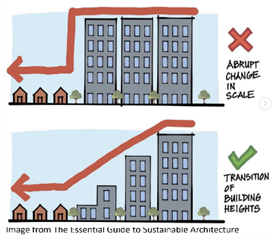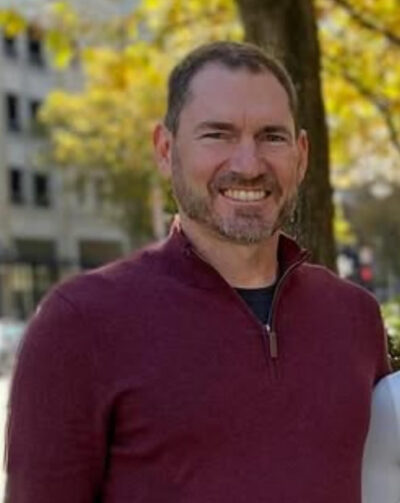
A Raleigh resident for 34 years and a proud homeowner in the historic Glenwood-Brooklyn neighborhood for 24, Roy Attride has been a dedicated neighborhood leader for many years. With a 22-year career in engineering including more than 7 years as a business leader before transitioning into the nonprofit sector in 2021, Roy Attride brings a balanced, solutions-driven perspective to community advocacy.
Passionate about fostering a successful, vibrant, and growing Raleigh, Roy advocates for thoughtful development that engages neighborhoods, supports smart transit and housing solutions, and ensures growth benefits all of Raleigh—not just a select few. Through Livable Raleigh, Roy shares insights, ideas, and advocacy for a Raleigh that thrives through collaboration, inclusivity, and sustainable progress.
We are reprinting this article from Raleigh Neighbors United (RNU)
Height transitions are essential urban planning tools that ensure livability, preserve sunlight, reduce heat, and maintain a walkable, human-scale city. Raleigh can and should grow—but it must stick to the plans that made it great. Ignoring these risks Raleigh’s future. RNU supports more housing and greater density, but it must be guided by long-term plans and include transitions, and urban design that will help Raleigh thrive. One-off rezonings like Z-12-25 undermine long range plans, affordability goals and set a harmful precedent for development citywide.
Height Without Transition Risks Raleigh’s Future
Roy Attride (Raleigh Neighbors United)
One of the questions RaleighNeighborsUnited.com has been asked about Z-12-25 is:
“Isn’t this the best place for height and density? Raleigh needs to grow up not out.”
Yes, but not 20-30 stories. Here’s why:
Raleigh Neighbors United agrees: Raleigh needs more housing and lower housing costs. We want Raleigh to thrive. Increasing housing supply is important, but that alone won’t solve affordability or ensure smart growth. We need a comprehensive strategy that includes building a diversity of housing types and price points, expanding Naturally Occurring Affordable Housing (NOAH), balancing individual ownership and
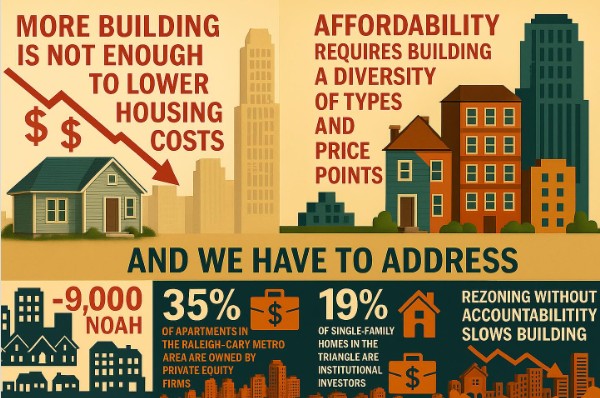
institutional investment, and incentivizing developers to ensure rezoned projects get built (read article). One-off upzonings, like Z-12-25, especially when they disregard planning policies, won’t deliver affordability or livability. They risk undermining the long-term strategy that Raleigh needs to thrive.
Raleigh must grow with more height and more density than we have today. But it must be done through long term planning, thoughtful growth, and promoting a diverse urban fabric.

These are the foundations of a thriving, equitable, and sustainable city. That’s exactly what Raleigh plans like the 2030 Comprehensive Plan and Capital Area Corridor Study were designed to achieve. These plans include clear policies on height, transitions, buffering, density, and the protection of neighborhoods and historic resources. Importantly, the existing 12-story zoning for the Z-12-25 site already reflects that thoughtful planning. It allows for a significant increase
in height and housing over what exists today. If built, it could become a valuable, plan-compliant development aligned with adopted city policy and urban planning best practices.
But Z-12-25 goes beyond the plans. One-off rezonings like this sidestep Raleigh’s policies, create unintended consequences, and undermine long-term sustainable success We’re already seeing the results: underbuilt density in the downtown core and unmet affordable housing promises. Raleigh can grow. It should grow. But it must grow according to the plans we’ve already put in place. Plans that reflect community input, sound planning, and a vision for a better city for all.

Why Height Transitions Matter
Maximizing building heights (20–40 stories) is not appropriate in every context and doing so without thoughtful planning would harm Raleigh and its residents. Height transitions (between buildings, within building stepbacks, and across zoning boundaries) are fundamental urban planning tools. They guide sustainable growth, support human-scale

development, and help build vibrant, livable cities that attract residents, businesses, and investment.
These transitions:
-
- Reduce
-
- overshadowing, ensuring sunlight reaches the street
- reflective glare
- overheating
-
- Make room for trees and vegetation, helping to cool the city and combat urban heat islands.
- Support airflow and wind management, improving comfort and climate resilience.
- Reduce
Just as important, these transitions:
-
- Create a human scale that enhances walkability, social interaction, and connection.
- Promote vibrant public spaces, making streets and spaces that are engaging, attractive, and rooted in a strong sense of place.
- Maintain visual continuity, encourage sustainable infrastructure, and protect a diverse, connected urban fabric.
These are not abstract planning ideals, they are the building blocks of a successful city. They’re what make Raleigh great. They shape its identity, enhance its beauty, and sustain its livability and appeal. Abandoning these principles would erode the very qualities that make people want to live, work, and invest in Raleigh.
Transitions Don’t Just Protect—They Create

Transitions in height and density don’t just protect, they create. They foster a mix of businesses, housing types, and investment opportunities, while building resilience to economic shifts. Pro-development policies have not realized projected benefits, sites remain undeveloped, affordable housing remains unmet, federal support is uncertain, and interest rates are high. Raleigh cannot afford to abandon the very principles that ensure its growth remains inclusive, balanced, and sustainable.
Conclusion
Raleigh can grow and it should but how we grow matters.
Approving Z-12-25 would ignore the very principles that have made Raleigh a city people love to live in, invest in, and care about. This rezoning is not aligned with Raleigh’s long-term plans, does not reflect sound urban planning practices, and sets a precedent that threatens every neighborhood across the city (see articles Z-12-25: A Threat to Every Raleigh Neighborhood , Z-12-25 and Risks to Mordecai, Roanoke Park, Georgetown, Mordecai Village and Glenwood-Brooklyn)
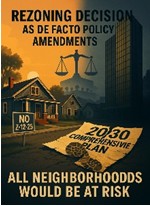
This is not about stopping growth. It’s about getting growth right. We already have thoughtful, community-informed plans like the 2030 Comprehensive Plan and the Capital Boulevard Corridor Study. These plans allow for significant new height and density, up to 12 stories on this very site, while still respecting transitions, neighborhood character, and sustainable infrastructure. Z-12-25 asks us to throw all of that out: the policies, the protections, the planning. All for 30 stories, 240 feet from homes.
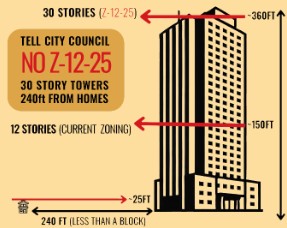
This is not smart growth. It’s short-term thinking with long-term consequences. Raleigh deserves better. We need to build housing that people can afford, in neighborhoods people want to live in, without sacrificing the qualities that define our city.
Say no to Z-12-25. Stick to the plan. Reinforce what makes Raleigh great and invest in its future because once it’s gone, we won’t get it back.
Roy Attride, Raleigh Neighbors United
The neighbors support the current zoning which allows for 12 stories.
12 stories IS DENSITY
12 stories provides needed housing
Read more about the West St proposal here: Raleigh Neighbors United
NOTE from Livable Raleigh – Mayor Cowell says she is keeping track of her email on the issue of the proposed 30-story tower at West St. If you are opposed to it and want to see Raleigh honor the Comprehensive Plan as Mayor Cowell said we should, then please email the Mayor and ALL the City Council to express your concerns. This email address will send your message to all council members: citycouncilmembers@raleighnc.gov or you can find complete contact information for each councilor and their social media accounts here: City Council Contacts
Stop Z-12-25 West St Tower – Sign the Petition
Growth with Consequences Risk to Neighborhoods
A Threat to Every Raleigh Neighborhood
Height Without Transition Risks Raleigh’s Future
The Impact of Cherry-Picking Policy – Part One
The Impact of Cherry-Picking Policy – Part Two
The Impact of Cherry-Picking Policy – Part Three
The Impact of Cherry-Picking Policy – Part Four
Is West St in the Core of Downtown?
Do City Plans have a Use By Date?
West St Tower Violates Raleigh Downtown Plan
West St Tower Violates Equitable Transit Development
West St Tower Violates the Capital Blvd Corridor Study
West St Tower Proposal Violates the Comprehensive Plan
West St Tower Neighborhood Meeting – All Stand!
Want to know more about these signs?
If you appreciate the kind of reporting we bring to you
|
Please donate $10 or $20, Thanks for supporting |
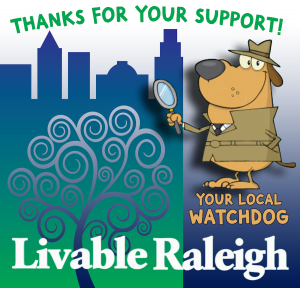 |

